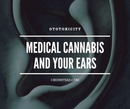What Are CB1 & CB2 Receptors?
CB1 and CB2 Differences & The Endocannabinoid System
It’s no surprise that Cannabidiol (CBD) is becoming more and more popular the more that studies are released showing its ability to actually help patients that have been searching for a long time. People with depression, fibromyalgia, rheumatoid arthritis, Crohn’s Disease, and so much more are finding relief that seemed impossible until now.
The question eventually arises, how does it work? How are all of these people all of the sudden getting better? The quick answer is because we are just now discovering solutions to ancient old problems. The long answer is the endocannabinoid system.
The endocannabinoid system works by utilizing certain receptors that are found all over the body. These receptors are called CB1 and CB2. Each of them has their own role to play in the endocannabinoid system, and each receptor is vital to homeostasis.
It’s All In Your HeadIn order for you to breathe, move, or think, your brain has to communicate with itself. Your brain is made up of tiny cells called neurons that use electronic impulses to send out messages to each other. These messages are hormones or neurotransmitters, which are chemicals that are used to get a reaction out of the receiving cell. The neurotransmitters have to travel through a tiny space called the synapse gap, and when the process is complete, your body knows to lift the spoonful of cereal to your mouth or to cry in a sad movie.
Sometimes your brain gets over excited and sends a wave of neurotransmitters to the receiving postsynaptic neurons, making them overwhelmed and unable to react. Thanks to the endocannabinoids retrograde signaling, it can help regulate the war zone going on in your head.
Endocannabinoids travel backward, which makes them most unique. While neurotransmitters are coming from presynaptic cells, the endocannabinoids are leaving from the receiving end. This grants more control over what is being received and what isn’t. Your brain can fire off whatever it wants to, but your endocannabinoids won't let it affect you unless it’s appropriate. And we have those endocannabinoids thanks to the endocannabinoid system.
The Endocannabinoid System
The endocannabinoid system (ECS) is made up of endocannabinoids, metabolic enzymes, and receptors. Its job is homeostasis, which is regulating your body so you can live comfortably. It is in charge of your eating habits, your sleeping patterns, and even your social habits. The ECS also controls inflammation, pain, and skin diseases. It helps your neurons navigate the neurotransmitters to the right receiver by either elevating the levels that are too low or decreasing the levels of a hormone that is overabundant.
EndocannabinoidsThese are just your body’s own version of cannabinoids. One of the most famous endocannabinoids is anandamide (AEA). High levels of AEA can reduce pain, which is what your body uses when you are experiencing pain. However, sometimes your natural chemistry isn’t enough. This is why many people take CBD medication because CBD elevates Anandamide that is already present in your brain.
Metabolic EnzymesMetabolic enzymes are the reason that you don’t have longs lasting effects of your endocannabinoids. These enzymes are proteins that break down structures that are no longer necessary, like anandamide. These enzymes also produce new cells and maintain existing ones until they are ready for retirement. Enzymes are in charge of sucking out the nutrients from our food and spreading it to the places we need it in the body and is even in charge of cleaning toxins out of the body.
Malfunctions in this area has been the cause behind many diseases like diabetes, obesity, hypertension, and several more. Without these enzymes, our brains could run crazy and do whatever they want. Luckily, our bodies try to keep that from happening.
ReceptorsReceptors are located on the surface of neurons and cells all over your brain and body. When a cell needs to send information, it is called the presynaptic cell. This is because it’s information, which is neurotransmitters and hormones, hasn’t passed through the synaptic gap yet. It used a small electronic impulse to send out the chemicals, and the receptors on the receiving end, on the postsynaptic cell, can sense the changes around its neuron and tell the inside to react appropriately. Without receptors, your cells would be deaf, and nothing would get done at all in your body.
The way the ECS works by recognizing errors that the body may be creating or continues to maintain the awesome job your body is doing. Some of the biggest reasons behind its accuracy are the receptors that receive messages throughout the body and brain. The two that are the most prominent today are CB1 and CB2.
CB1 Receptors
CB1 receptors are densely populated in the brain, but can also be found throughout the body. By activating CB1 receptors with endocannabinoids, your brain can produce long or short term changes on the conversation between your neurons.
THC Shows Us What CB1 Can DoThe CB1 receptor is the most famous for its compatibility with THC. CB1 receptors are the reason that you feel that euphoric high when you consume cannabis with high enough THC content. THC is a good indicator of what all CB1 receptors are in charge of because THC activates it. With THC you may feel tired, you may feel euphoric and happy, you may feel less pain, and you may have an uncontrollable appetite. This is because the CB receptor is in charge of your sleep, your mood, your pain, and your diet.
CB1 And The G-Protein Super FamilyCB1, as well as CB2, is also a member of the G-Proteins Coupled Receptors superfamily. This means it regulates ion channels which help with cell regeneration, efficiently transporting nutrients, and smooth muscle contractions. It’s critical in the nervous system because these channels help moderate how much electricity is getting sent through synapses to ensure your brain doesn’t fire off too many signals.
CB2 Receptors
CB2 is evenly distributed throughout the body, unlike its counterpart CB1. CB2 has been mostly seen in immune cells while also being found in several neurons. During inflammation, there is actually an increased number of receptors for activation, showing the role of the receptor in the process of homeostasis. The more CB2 receptors present, the more work they can do.
InflammationWhen you experience inflammation, generally speaking, it is a very normal and healthy thing to happen. When you see parts of your body swell up, it is that section of your body that is getting filled with a liquid that has immune cells that are trying to protect you from pathogens in your body. The endocannabinoids that interact with the CB2 receptor make sure that the inflamed area doesn’t spread, and doesn’t overstay its welcome. Chemical imbalances and brain injury can cause your brain not to recognize when the threat is over. It might even tell your brain new threats have begun and it needs to attack! Hemp oil helps improve the functionality of your CB2 receptor, making inflammation a thing of the past.
Skin ConditionCB2 receptors are also found to be very active in the skin. People who may have a malfunctioning endocannabinoid system may get skin diseases like eczema and psoriasis. CB2 helps replenish old skin cells, it heals damaged ones, and throws out the dead ones. It also reduced inflammation, which is a prominent symptom of skin disease. And since there are CB2 receptors underneath the epidermis, using topical CBD medications can help with painful conditions.
When Boosted With CBDWhen you take CBD medication, it interacts with your CB1 receptor the same way your endocannabinoids do. This means that if your body isn’t functioning properly with the endocannabinoid system, CBD can help.
Considering CB1 regulates your mood, diet, sleeping, and pain sensations, it wouldn’t be a surprise to say that CBD can help with all of those things.
When You Mix CBD, CB1, and CB2
Appetite RegulationIf you over eat, or can’t eat, CB1 might be the culprit. When you mix in CBD, you can regulate your appetite to help you lose or gain weight. We have a great article about CBD for Weight Loss, check it out!
Sleep Pattern RegulationIf your sleep patterns are unusual, you might not be getting a full nights rest because you are skipping cycles or getting interrupted. CBD can help regulate sleep cycles when paired with the CB1 receptor. Many people have insomnia because of pain or anxiety. When you mix CBD and CB1 receptors, you can nip both of those in the bud and get some sleep.
Mood RegulationWhen combining CBD and CB1 receptors, you can have your life back. Many people suffer from depression, anxiety, or other mood disorders, but this dynamic duo of CB1 and CBD can knock out some of the most severe mood disorders. By helping your CB1 receptor be more aware of its surroundings, it can send endocannabinoids to quiet down the neurotransmitters that are driving you insane. Literally.
Less Sensitivity To PainCBD can dim down the chemicals that tell your body to feel pain and raises the levels for the chemicals to tell your body to feel good. When you pair CBD and CB1, you get the added benefit of AEA, and the CBD blocks the enzymes from eating it all up giving you a longer lasting natural relief from your pain.
Less InflammationWhen your body is attacking itself, you may feel like you’re in a helpless situation. Well, not anymore. When you mix CBD and CB2, you build a powerhouse team that goes in for cleanup on your afflicted areas. Through CB2, CBD tells your immune cells to calm down because we want peace not war behind this wall of the epidermis.
A round of applause for the CB1 and CB2 receptor because we wouldn’t be who we are today without them. Our skin would probably fall off, our bodies would be in constant pain, and we would all be raving lunatics. Some of us have some of those problems, like skin falling off and constant pain. And that’s why we have CBD, to pick up the slack our system can no longer handle.










